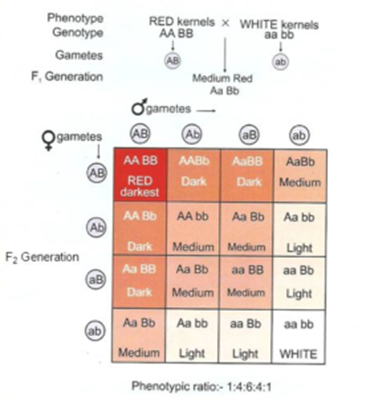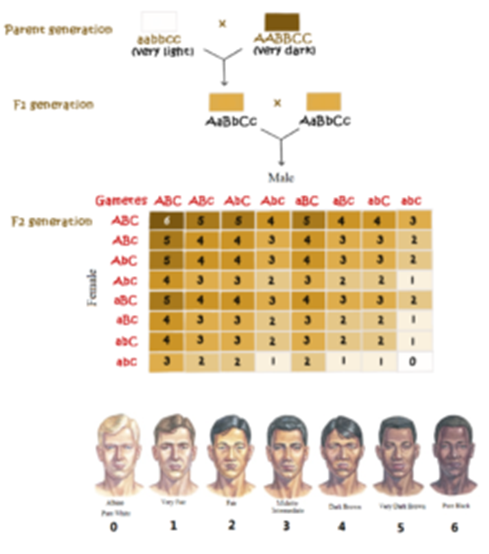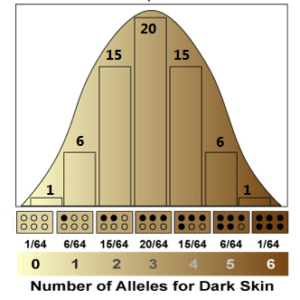Science > Biology > Genetic Basis of Inheritance > Polygenic Inheritance
Mendel performed his experiments with garden pea plant, which has traits or alleles having complete dominance and hence the laws of inheritance were proved. Other scientists performed their experiments on different plants and animals and found deviations to Mendelian ratios. Depending upon these experiments and observations, a different pattern of inheritance called gene interactions was discovered. This study is known as Post – Mendelian genetics or Neo-Mendelian genetics. In this article, we shall study the concept of polygenic inheritance.
Polygenic Inheritance or Quantitative Inheritance:
These characters are determined by two or more gene pairs and they have an additive or cumulative effect. These genes are called cumulative genes or polygenes or multiple factors. Polygenes are two or more different pairs of nonallelic genes, present on different loci, which influence a single phenotypic character and have an additive or cumulative effect. They are also called quantitative genes or cumulative genes or multiple factors.
A single phenotypic character governed by more than one pair of genes is called polygenic character or quantitative character. Polygenic characters or quantitative character show continuous variation. Galton (1883) predicted that in human population characters such as height, skin colour and intelligence show continuous variations in expression and not only two contrasting expressions.
In cumulative or polygenic inheritance each gene has a certain amount of effect. So more is the number of dominant genes, the greater is the expression of the character. It is generally believed that during evolution there was a duplication of chromosome or chromosome parts. This resulted in multiple copies of the same gene. Note that Mendel studied qualitative inheritance, where complete dominance is observed.
Polygenic Inheritance in Wheat Kernel Colour:
Swedish geneticist H. Nilsson-Ehle discovered polygenic inheritance. He crossed a red kernelled variety of wheat with white kernelled variety. In F1 generation all plants have grains with intermediate colour between red and white. In F2 generation five different phenotypic expressions (the darkest red, medium red, intermediate red, light red, white) appeared in the ratio 1:4:6:4:1. Nilson Ehle suggested that the kernel colour in wheat is controlled by two pairs of genes, Aa and Bb. Genes A and B determine the red colour. a and b which do not produce red colour pigment and their expression is a white colour of the kernel.

Polygenic Inheritance in Human Skin Colour:
The presence of melanin pigment is responsible for the colour of the skin in a human being. Each dominant gene is responsible for the synthesis of a fixed amount of melanin. The amount of melanin synthesized is directly proportional to the number of dominant genes.
The amount of melanin developing in persons is determined by three pars of genes A, B, C. These are present on three different loci and each dominant gene is responsible for the synthesis of a fixed amount of melanin. A genotype of a pure black parent in which melanin is produced is the highest is AABBCC, while that of pure white also called albino no melanin is formed is aabbcc.
Mulattoes i.e. F1 offspring produce (23 = 8) different types of gametes. Let us consider mulatto intermediate whose genotype is AaBbCc. By doing cross among two mulatto intermediate we get (26 = 64) combinations in F2 generation. But there only 7 phenotypes due to a cumulative effect of each dominant gene.

When we analyze all possible combinations and plot the probability graph by taking frequency distribution of colour, the number of dominant genes in various shades on the x-axis and the frequency of different shades onthe y-axis. In Polygenic inheritance often we get a bell-shaped curve as shown below.

This means that most people fall in the middle of the phenotypic range, such as skin colour, while very few people are at the extremes, such as pure white or pure dark. At one end of the curve will be individuals who are recessive for all the alleles (for example, aabbcc). They are rare; at the other end will be individuals who are dominant for all the alleles (for example, AABBCC) they are rare. In the middle of the curve will be individuals who have a combination of dominant and recessive alleles (for example, AaBbCc or AaBBcc). The graph also shows that the expression level of the phenotype is dependent on the number of contributive alleles and hence more quantitative.
Other examples are the height of human being, cob length of maize.
Comparative Study of Qualitative and Quantitative Inheritance:
Qualitative Inheritance:
- Qualitative characters are classical Mendelian traits which have two contrasting expressions and are controlled by a single pair of genes. e.g. tall and dwarf pea plants. A qualitative character can be expressed by a single pair of the gene. Hence the traits are called monogenic traits. The inheritance of monogenic traits (monogene) or qualitative characters is called qualitative or monogenic inheritance.
- A qualitative trait is expressed qualitatively, which means that the phenotype falls into different categories. These categories do not necessarily have a certain order.
- Qualitative inheritance was first studied by Mendel.
Characteristics of Qualitative Inheritance:
- A quantitative inheritance or monogenic inheritance deals with the inheritances of qualitative characters which have two contrasting expressions e.g. tall and dwarf pea plants.
- Each character is controlled by a single pair of contrasting alleles.
- There is no intermediate type.
- Each character has two distinct contrasting expressions i.e. they exhibit two distinct phenotypes.
- The degree of expression remains the same whether the character is controlled by one or both the dominant genes.
- Single effect genes are seen.
- It is not influenced by environmental factors.
- It shows a discontinuous pattern of inheritance.
- Individuals of F1 generation resembles the dominant parent.
- Individuals of the F2 generation are in the ratio 3:1. An intermediate expression is absent.
- It concerns with individual matings and their progeny.
- Analysis of this inheritance can be done by counting and finding ratios.
- Examples: Inheritances of qualitative characters like height, seed coat and seed colour of the pea plant.
Quantitative Inheritance:
A quantitative inheritance or polygenic inheritance deals with the inheritances of quantitative characters like height, weight, skin colour, intelligence, etc in the human population and exhibits continuous variation. Few characters in plants like height, the size, shape, number of seeds and fruits also exhibit quantitative inheritance.
In quantitative inheritance each gene has a certain amount of effect and the more number of dominant genes, the more is the degree of expression of the character. The gradation in the expression of the characters is determined by the number of gene pairs and all the gene pairs have an additive or cumulative effect.
Quantitative or polygenic inheritance was first studied by J. Kolreuter (1760) in case of height in tobacco and F. Galton (1883) in case of height and intelligence in human beings. Nilsson-Ehle (1908) obtained the first experimental proof of polygenic inheritance in case of kernel colour in wheat. The possible origin of polygenic inheritance is due to the duplication of a chromosome or its part, the increase in chromosomes number (Polyploidy) or the mutations producing genes having the similar effect.
Characteristics of Quantitative Inheritance:
- A quantitative inheritance or polygenic inheritance deals with the inheritances of quantitative characters.
- Each character is controlled by more than one pair of nonallelic genes (polygenes)
- In the case of one polygene pair, the number of phenotypes is 3 (1: 2: 1). In the case of two polygene pairs, the number of phenotypes is 5 (1: 4: 6: 4: 1). In the case of three polygene pairs, the number of phenotypes is 7 (1 : 6: 15: 20: 15: 6: 1). Thus the number of intermediate types increases with the increase in the number of polygenes but the number of parental types remains the same
- Each character has an intergrading range of phenotypes.
- The degree of expression depends on the number of dominant genes.
- Single effect gene cannot be seen.
- It is influenced by environmental factors.
- It shows a continuous pattern of inheritance.
- F1 generation shows intermediate expression between the two parents.
- In F2 generation individuals with intermediate genotype and phenotype are maximum.
- It concerns with a population of organisms consisting of all possible kinds of matings.
- Analysis of this inheritance needs an appropriate statistical method and is complicated.
- Examples: Inheritances of quantitative characters like height, weight, skin colour, intelligence, etc in the human population. Few characters in plants like height, the size, shape, number of seeds and fruits also exhibit quantitative inheritance.